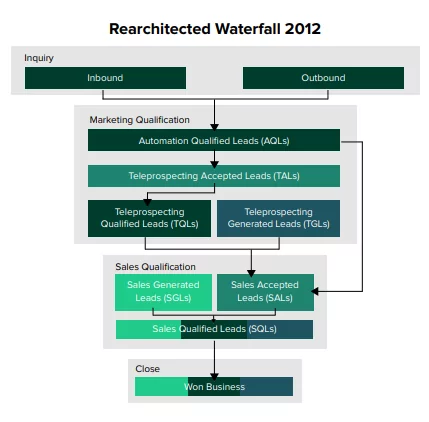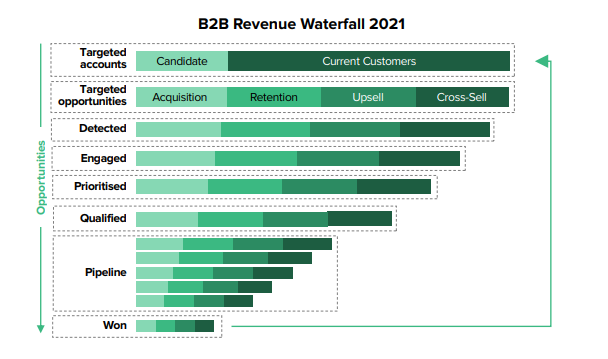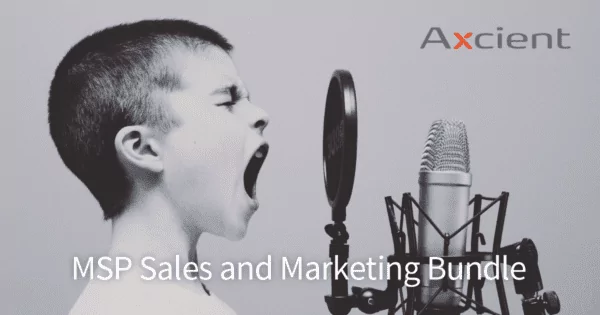
B2B Revenue Waterfall: 8 Tips for Optimizing Your Revenue Growth Engine
Forrester’s B2B Revenue Waterfall™ is a valuable marketing and sales tool for MSPs. Designed to help B2Bs accelerate opportunity development and revenue growth, this modern framework utilizes the latest research in demand generation for realistic sales strategies.
Keep reading to find out…
- What the new framework looks like compared to the old.
- How modern buying scenarios have rearchitected the model.
- 8 tips for getting the B2B Revenue Waterfall right.
Table of Contents
Upgrading from Demand Waterfall to B2B Revenue Waterfall
The SiriusDecisions Demand Waterfall® framework was first introduced in 2002 and revised in 2012. In 2021, the model was updated and rereleased as the B2B Revenue Waterfall after Forrester purchased SiriusDecisions in 2019. The new Forrester model is based on the latest statistics from their B2B Buying Survey, which is conducted every two years. Two waterfall-defining factors revealed in the latest 2021 study have largely impacted this latest iteration: buying groups and the opportunity mix. More on those in a bit…
The overall goal of the B2B Revenue Waterfall is to align marketing, revenue development, and sales to better identify, engage, qualify, and win opportunities. As seen in the two latest models below, the B2B Revenue Waterfall focuses on both candidates and current customers versus just leads in the Demand Waterfall architecture of 2012. Broadening demand to include both prospects and existing customers presents new opportunities for marketing and sales. Now, they can help buyers throughout their journey instead of being limited to a single sales funnel or revenue pipeline.


Transitioning from Individual Leads to Dynamic Buying Groups
The most notable paradigm shift from the Demand Waterfall to the B2B Revenue Waterfall is in response to how B2B buying decisions are made. Traditionally, B2B sales is a transaction occurring between the seller and one B2B buyer – typically a C-suite role or high-ranking business leader. However, today’s buying decisions are made in a buying group.
Within buying groups there are multiple individuals with their own vested interests in a particular solution based on their unique needs and priorities. For example, technicians are concerned with usability and integration, business owners need cybersecurity insurance and business continuity, and finances look at the bottom line. With this updated perspective of a customer’s buying journey, the seller now has multiple opportunities to sell within one organization. For this reason, the B2B Revenue Waterfall focuses on buying groups rather than leads.
“This year’s [2021] Forrester B2B Buying Study shows that more than 80% of purchases now involve complex buying scenarios: consensus scenarios where 95% of current purchases involve three or more people across two or more departments, and committee scenarios where strategic purchases include multiple people and departments across the organization and require executive oversight.”
– FORRESTER
Acknowledging the Opportunity Mix
The opportunity mix accounts for four different opportunity types: 1.) net new logo acquisition opportunities, 2.) existing customer cross-sell and 3.) upsell opportunities, and 4.) retaining existing customer deals. Not only does each opportunity type convert at different rates and stages, but they also influence revenue goals differently. If your MSP gets 70% of your revenue from renewing existing customers, you’ll invest more in that opportunity type rather than net new logo acquisition.
According to Forrester, “Of the four opportunity types,
- Acquisition opportunities typically exhibit the longest sales cycles and lowest overall conversion rates.
- Cross-sell opportunities typically exhibit somewhat better conversion rates and cycle times than acquisition opportunities.
- Upsell opportunities tend to perform much better than cross-sell opportunities.
- Retention opportunities tend to convert at the highest rate of all opportunity types, though their cycle times are dictated by contract terms and product lifecycles.”
8 Tips to Optimize Your B2B Revenue Waterfall
Whether you’re moving from the Demand Waterfall to the B2B Revenue Waterfall or implementing a waterfall framework for the first time, here are eight tips for getting it right.
#1: Know your sales cycle. Get a clear, accurate, and comprehensive picture of your sales cycle, including lead generation, sales engagement, upsells, cross-sells, and new sales, to define your goals and inputs. What revenue changes do you expect to see, and within what timelines?
Once that’s established, work your way up the waterfall slicing and dicing what you have by customer size, product, lead origin, time in the sales cycle, or whatever makes sense for your goals. Focus on the data you have, as well as what you still need to fill in the blanks.
#2: Validate your data. Too often, companies fall victim to stale data repetition. Someone will state a fact that might have been true years ago but hasn’t been validated for your current revenue goals. This goes for both the data you have, as well as the data you don’t have. Skewed or inaccurate data will disrupt your entire B2B Revenue Waterfall, so make sure you use valid data to make informed decisions.
#3: Establish achievable goals. Set your marketing and sales teams up for success by ensuring that you have the people, time, resources, and automation necessary to accomplish revenue goals. Strike a balance between what the business needs, how long it should take to reach goals, and the flow of leads necessary to accomplish wins. Do you have enough sales reps, account managers, and marketing team members? Are lead flows and existing customer conversations heavy enough to achieve desired wins based on established conversion rates? Realistic expectations can motivate teams toward continuous improvement, while unobtainable goals can kill morale.
“Conversion rates between stages measure how effectively the organization is executing each of those steps. The flow of opportunities from stage to stage within the Waterfall is also measured in terms of volume of opportunities and the velocity at which they move from stage to stage.”
– FORRESTER
#4: Leverage the B2B Revenue Waterfall across teams. The information revealed in your waterfall shouldn’t be siloed. Instead, use it to help marketing and sales teams regularly focus on the best opportunities available. Incorporate the data in weekly or monthly meetings to give everyone an idea of where their efforts are producing and lacking. Use it to motivate, reward, or change strategies and bring the business together with standard measures of success.
#5: Collaboration is key. The B2B Revenue Waterfall joins marketing and sales efforts across the customer buying journey. Historically, these departments have struggled to unify, but achieving cross-team collaboration drives revenue growth. Data requires context to produce value, and that comes from open discussion.
You may discover that some leads are being contacted too early in the sales cycle, and a drip campaign could move them closer to having that one-on-one sales interaction. Together, you can rate leads to constantly refine where resources should be directed for the biggest impact. Revisit the B2B Revenue Waterfall framework and your analysis to ensure that everyone is aligned on where resources are spent and why.
“According to Forrester, a sales- and marketing-aligned demand management process leads to better conversion rates (pipeline-to-close ratio) and higher average deal sizes.”
#6: Listen to your sales reps. Just as important as collaboration is, is each department’s niche expertise. The anecdotal and real-life experiences of sales reps with your potential and current customers can lend meaning and context to data. Create a culture that invites and encourages sales reps to speak honestly about their ideas and unique knowledge. You might be surprised by what you hear.
#7: Keep CRM fields simple. Implementing a customer relationship management (CRM) system with your operations, marketing, and sales teams gives all departments the opportunity to see the data they need. However, first and foremost, it must be simple to use and not hinder any one team from accessing and applying the information. Otherwise, people won’t use it, or worse, you could be acting on skewed data.
Don’t let analysis paralysis compromise selling. Choose the five most important data points between the three departments and make those fields required. Explain to your sales reps why these fields are important to encourage adoption and correct use. Additionally, figure out how to leverage automated inputs, which can also contain a lot of value. It can be challenging to simplify data needs, but it will streamline data application for more efficient decision-making.
#8: You don’t need a fancy system. Many MSPs utilize a CRM system, but if it’s not in the budget, you can still get the benefits of a B2B Revenue Waterfall. There is a range of CRM platforms available, so first, evaluate the cost against the potential wins of having the data available. If you need to rely on spreadsheets for a time, it’s better than nothing. It may make the case to business leaders for the value of investing in a CRM. After all, some data is always better than no data.
Move Customers Through Your Waterfall with the FREE MSP Marketing Playbook Bundle!
The B2B Revenue Waterfall is the framework, and the MSP Marketing Playbook Bundle is the how-to. Get three resources in one in this free guide for MSP marketing and sales growth:
- Paid Search and SEM for MSPs: How to Stand Out in Search and Ads
- MSP Marketing and Sales Tactical Guide: 4 Ways to Grow Your Business on a Budget
- MSP Marketing Guide to Optimal Target Verticals: What verticals should MSPs target, and which have the highest rewards?
More Great Stuff From Our Blog:
Check out some other interesting pieces from our blog: we examined the toll cybersecurity has on MSPs’ mental health and offered a comprehensive list of tools and resources to feel better. Also, we dove into how chain-based backup works and why chain-free is the way to be, we talked with Jason Phelps from Huntress Labs about planning for the next ransomware attack, we explained why the current cybersecurity landscape means traditional backup is dead, we showed you how to ditch pricey on-site appliances with Local Cache for Direct-to-Cloud BCDR.
Author
Related posts
How well could you sleep with reliable cloud-based backups and recovery?
Take a deep dive into Axcient’s proprietary, automated security features to see how we’re ensuring uninterrupted business continuity — no matter what:




